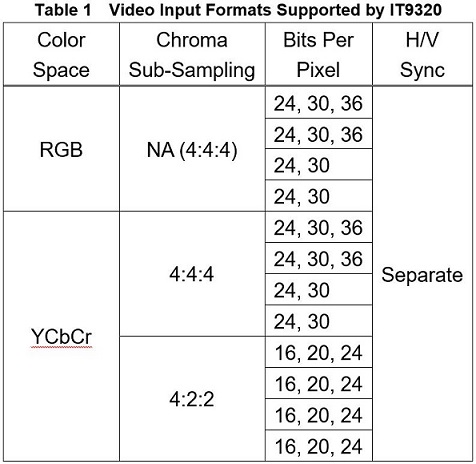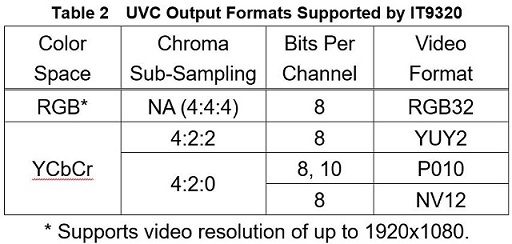IT9320: Digital Video to USB3 Converter


IT9320 is a series of bridge ICs that convert digital video and audio input to the USB packet output. The series includes IT9323TE, IT9325TE, and IT9327G. The packaging for IT9323TE and IT9325TE is thin quad flat pack (TQFP) with 144 pins and exposed E-pad. While for IT9327G, it is thin-profile fine-pitch ball grid array (TFBGA) with 196 balls.
IT9323TE supports input video data rates up to 3840 x 2160 30Hz, while IT9325TE and IT9327G support input video data rates up to 3840 x 2160 60Hz. Output video data rates up to 3840 x 2160 30Hz are supported by IT9323TE, IT9325TE, and IT9327G. The main input of IT9320 is LVTTL digital video interface with external H- and V-Sync, and the output of IT9320 is USB 3.1 Gen 1 (SuperSpeed USB) interface.
The digital video signal received from the LVTTL input is converted into USB Video Class (UVC) video streams and sent through the output interface. No video compression other than chroma sub-sampling is performed in the process of data conversion, so the quality of the video can be well preserved.
IT9320 is also equipped with several video processing engines, which can be enabled to pre-process the video to better meet the application's requirements. In addition to video, IT9320 also has digital audio input and output interface. The digital audio signal received from the digital audio input interface is output as USB Audio Class (UAC) audio stream.
The main input interface of IT9320 comprises LVTTL signal pins (balls), including VSYNC, HSYNC, DE, PCLK, and remaining data pins. The interface can operate in the double-data-rate (dual-edged) mode, in which signal from each data pin is clocked by both the rising and falling edges of PCLK, or the single-data-rate (single-edged) mode, in which signal from each data pin is clocked by only the rising or falling edge of PCLK.
For IT9325TE and IT9327G, the LVTTL input can be one pixel (single-pixel mode) or two pixels (even-odd, dual-pixel mode) in parallel for both double-data-rate and single-data-rate modes. For IT9323TE, only the single-pixel mode is supported. The maximum input PCLK frequency is 148.5 MHz. For IT9323TE, with dual-edged mode, the input data rate can be as high as 297M pixels/second. For IT9325TE and IT9327G, with dual-edged and dual-pixel mode, the input data rate can be as high as 594M pixels/second.
The main output interface of IT9320 is a standard USB 3.1 Gen 1 (SuperSpeed USB) interface, which is capable of transmitting a maximum data rate of 5 Gbps to the host. The output video stream complies with the UVC specification, so a USB device based on IT9320 works automatically with system-supplied UVC driver, thus maximizing compatibility to various computer operating systems and video players.
Video processing engines in IT9320 include 2D and 3D de-interlacer, up and down scaler, color-space converter, chroma sub-sampler, frame-rate converter, flip and mirror, and many others. The video processing engines also include a High Dynamic Range (HDR) to Standard Dynamic Range (SDR) converter.
The conversion process includes dynamic ratio conversion, which maps the high video dynamic range of HDR videos to the standard dynamic range, and color gamut mapping, which maps BT.2020 wide color gamut to BT.709 standard color gamut. This feature is very convenient when an HDR10 input video is to be delivered using USB Video Class (UVC) interface, which does not support HDR video; or when an HDR10 input video is to be displayed on an SDR display. This function ensures the same video appearance across different output devices. These engines can be configured or turned on or off by register programming.
The input and output video formats supported by IT9320 are listed in Table 1 and Table 2 respectively.
In addition to video, IT9320 also has two I2S digital audio inputs and one I2S digital audio output. Each I2S digital audio input receives up to two audio channels, each having 8, 16, or 24 bits per sample. Digital audio signal samples received from both I2S inputs are stored in DDR buffers, and can be optionally processed by the CPU, and then sent to the USB output as UAC endpoints or to the I2S audio output at a sample rate of 48 kHz.









